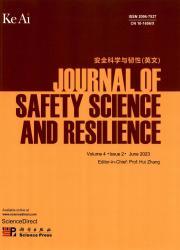Combining Bayesian Networks and MCDA methods to maximise information gain during reconnaissance in emergency situations
IF 3.4
Q1 PUBLIC, ENVIRONMENTAL & OCCUPATIONAL HEALTH
引用次数: 0
Abstract
In the immediacy of an event that disrupts the operation of an infrastructure, the time between its occurrence and the arrival of qualified personnel for emergency response can be valuable. For example, it can be used for gathering information about the status of the infrastructure by using automated reconnaissance devices. In an operation that precedes the intervention of human first responders, such devices can gather information about the situation, providing knowledge about the locations of stressors (e.g. fire), the inaccessibility of parts of the infrastructure or the presence of hazardous materials. In this study, we show how a Bayesian Networks can be used for knowledge representation and how it can be combined with methods from the realm of Multi-Criteria Decision Analysis (MCDA) for situation reconnaissance and route-optimisation in emergency situations, where different criteria (current belief about the location of zones of special interest, such as emergency exits, distance to the next point of interest, etc.) can be considered. As an example, we consider the case of an outbreak of a fire in a building. A pedantic check of all rooms by an automated reconnaissance device would take too long and thus delay intervention. Due to the limited time in which the building can be explored, the route is optimised to gather the greatest possible amount of information in the available time window. Results show how it is possible to maximise the information collected in a limited time window. This is done by discovering the location of fire and any hazardous materials through causal inferences automatically calculated by the Bayesian network. Route optimisation is facilitated by sequential MCDA using a parameter selection that meets the priorities of the specific application example.
结合贝叶斯网络和MCDA方法,在紧急情况下侦察时最大限度地获取信息
在立即发生破坏基础设施运行的事件时,从事件发生到合格的应急人员到达之间的时间可能是宝贵的。例如,它可以通过使用自动侦察设备来收集有关基础设施状态的信息。在人类第一响应者介入之前的行动中,这种装置可以收集有关情况的信息,提供有关压力源位置(例如火灾)、部分基础设施难以接近或存在有害物质的知识。在本研究中,我们展示了如何将贝叶斯网络用于知识表示,以及如何将其与多标准决策分析(MCDA)领域的方法相结合,用于紧急情况下的态势侦察和路线优化,其中可以考虑不同的标准(关于特殊利益区域位置的当前信念,例如紧急出口,到下一个利益点的距离等)。作为一个例子,我们考虑在建筑物中发生火灾的情况。通过自动侦察装置对所有房间进行迂腐的检查将花费太长时间,从而延误干预。由于探索建筑物的时间有限,因此优化了路线,以便在可用的时间窗口内收集尽可能多的信息。结果表明,如何在有限的时间窗口内最大限度地收集信息。这是通过贝叶斯网络自动计算的因果推理来发现火灾和任何危险物质的位置来完成的。通过使用符合特定应用示例优先级的参数选择,顺序MCDA促进了路由优化。
本文章由计算机程序翻译,如有差异,请以英文原文为准。
求助全文
约1分钟内获得全文
求助全文
来源期刊

安全科学与韧性(英文)
Management Science and Operations Research, Safety, Risk, Reliability and Quality, Safety Research
CiteScore
8.70
自引率
0.00%
发文量
0
审稿时长
72 days
 求助内容:
求助内容: 应助结果提醒方式:
应助结果提醒方式:


